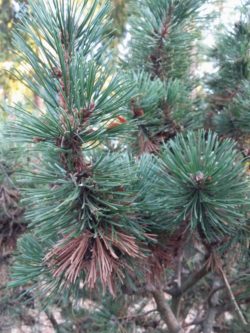
Seasonal Evergreen Foliage Changes
Autumn in the Pacific Northwest is heralded by the bright leaf color change in prominent deciduous tree species. Many Portland area residents are surprised to learn that many evergreen trees also exhibit seasonal change in their foliage at this time of year.
Deciduous and evergreen trees have foliage that converts sunlight into energy. Deciduous trees lose all of their leaves at once at the end of every growing season as the temperatures drop and the sunlight wanes. Evergreen trees also lose their foliage, just not all at once. Evergreen foliage persists for more than one growing season, then falls off. This gradual loss of foliage means that there is always some foliage growing on a healthy evergreen tree. The length of time each evergreen tree species keep their leaves before falling off varies widely. Some pines retain needles for only two years and some spruce retain needles for up to seven years. Many evergreen trees exhibit discoloration of foliage before it falls off.
Normal foliage loss in evergreen trees is loss of older foliage due to decreasing photosynthesis. Foliage that does not photosynthesize as well as the rest is a liability to the tree. Shade and dirt both contribute to the inefficiency of the older foliage. Because younger foliage grows closer to the tip of the branch and older foliage grows closer to the base of the branch, the older foliage does not receive as much sunlight as the younger foliage. The sunlight that the older foliage does receive is filtered through a thicker layer of dirt that has coated the needle over the course of its growth.
Although many evergreen species lose their leaves throughout the year, some species show marked seasonal foliage loss. This seasonal foliage loss is more pronounced with drought stress.


Western redcedar trees exhibit very noticeable seasonal foliage color change, as seen above. The picture at left shows the location of the dying needles on the innermost part of the branches. The picture at right highlights the stark contrast of the rust-colored older needles with the waxy green of the younger needles. This phenomenon is called flagging and is a normal part of the life cycle of the plant. The winds of winter will eventually blow the dead needles out of the canopy.

Pine trees are another family of evergreen trees that exhibit notable seasonal foliage loss of the innermost needles. The Mugo pine seen above has dry, brown needles closer to the base of the branches.

We receive a number of questions every fall from clients concerned about their evergreen tree health due to foliage discoloration. The seasonal discoloration and loss of older foliage in evergreens is a normal part of a tree’s life cycle. There are diseases and insects that also cause foliage loss, but the loss pattern differs. Seasonal evergreen foliage loss will blow away in winter and not return until the following year. By mid-winter, the cinnamon-colored needles of the Giant Sequoia seen above will have mostly fallen off and the tree will look greener overall.


